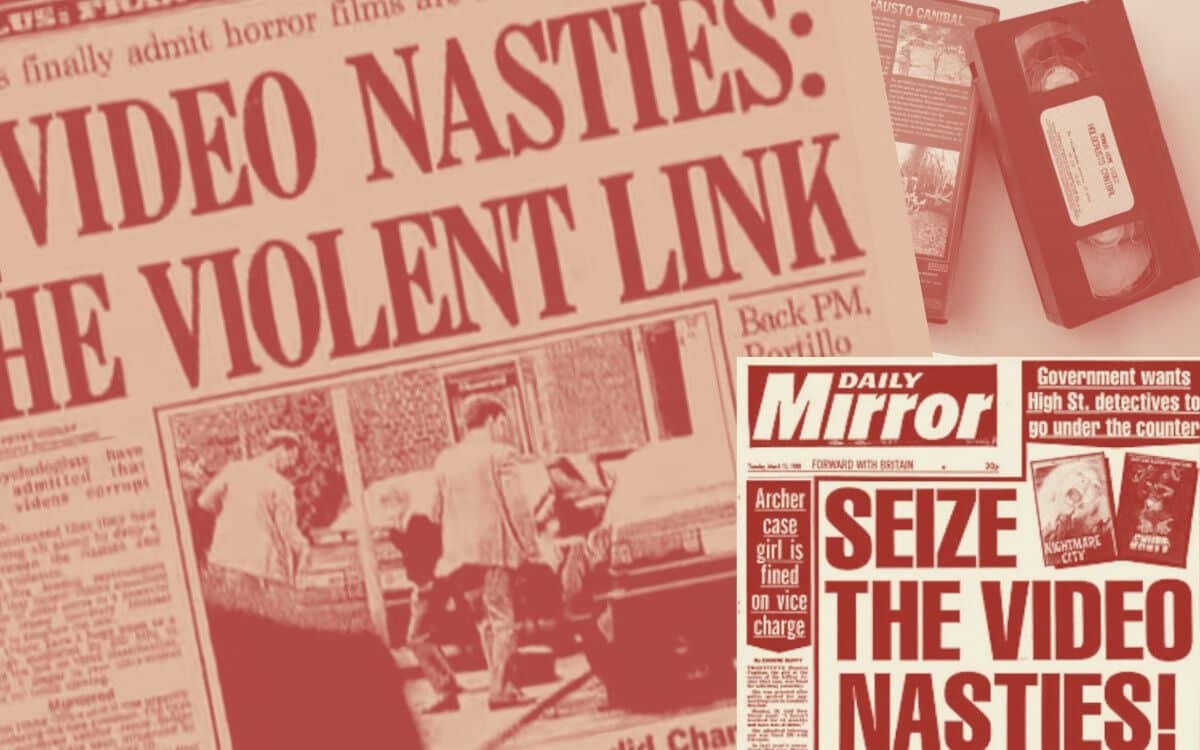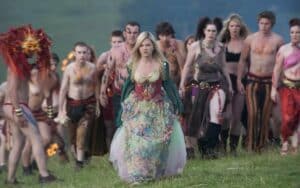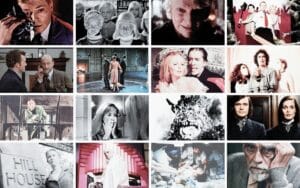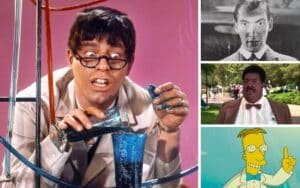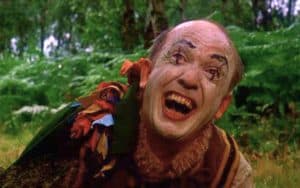1980s Britain saw moral panic over “Video Nasties,” VHS horror films blamed for corrupting youth. DAVID TURNBULL explains the resulting media hysteria and censorship crackdown
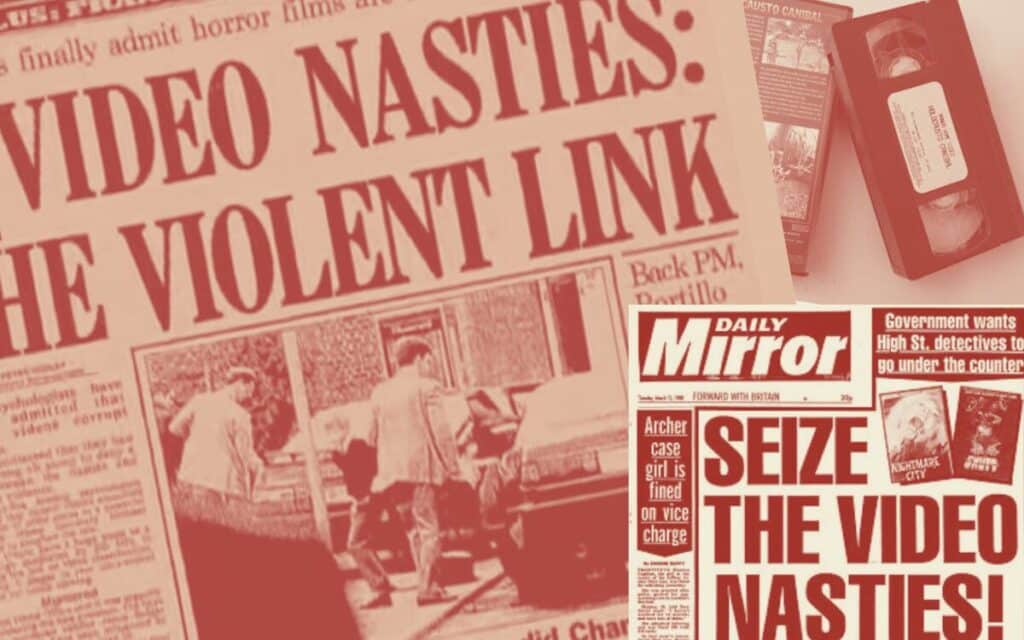
The early 1980s saw Britain gripped by a moral panic brought about by ‘so-called’ video nasties, graphically depicted horror films that were said to be corrupting the nation’s youth. A loophole in the law had allowed titles such as Driller Killer and Cannibal Holocaust to bypass the British Board of Film Censors by being available only on VHS video than through release in cinemas.
The term video nasty was coined by the Mary Whitehouse led National Viewers and Listeners Association who campaigned and lobbied for action by the authorities. When the Sunday Times carried an article entitled ‘How High Street Horror is Invading the Home’, other newspapers such as The Daily Mail and The Sun jumped on the bandwagon, publishing lurid tales about how this film or that film was leading to acts of violence and even Satanic worship by those who came under the influence of what they said to be shockingly depraved movies, which could be taken home and watched by teenagers on the increasingly popular video recorders attached to their parents’ televisions sets.
In response to the growing outcry the Director of Public Prosecutions issued a list of 72 movie titles it believed to be in breach of the Obscene Publications Act (1959) and second list of 82 titles which could be lawfully confiscated under the provisions of the Act. This list was used by John Anderton, Chief Constable of Greater Manchester, a devout Christian, who essentially set himself up as the Video Finder General, authorising raids of video stores and seizures of allegedly offensive materials. These raids were emulated across the country by other police authorities.
Meanwhile, the National Listeners and Viewers Association had persuaded Conservative MP, Graham Bright, to sponsor a Private Member’s Bill. When the Government backed the Bill, the Video Recordings Act 1984 came into force. Under this Act the British Board of Film Censors was renamed the British Board of Film Classification and their remit extended to include films released directly video. The consequences of the Act had repercussions for more mainstream horror movies which had already been seen by the public in cinemas, both The Exorcist and Straw Dogs were refused video certification under its provisions.
This was not, however, the first time the genre of horror had provoked outrage amongst those who considered themselves to be the moral guardians of the nation’s welfare.
In the Victorian era Penny Dreadfuls, which brought us iconic horror characters such Sweeney Todd (the Demon Barber), Varney the Vampire, Spring Heeled Jack, and others, provoked the same sort of reaction. Along with tales of highwaymen such as Dick Turpin and Dashing Claude Duval, and wayward gangs of criminal youth, such as The Wild Boys of London, the Penny Dreadfuls were blamed for moral decline and increasing lawlessness amongst the children of the lower classes.
An article in the July 1890 issue of Quarterly Review described Shoe Lane near Fleet Street, where many of these titles were published, as a factory of the literature of rascaldom – a literature which has done much to people our prisons, our reformatories, and our colonies, with scapegracers and ne’er-do-wells.
A few years earlier Lord Shaftesbury, in an address to the Religious Tract Society, had warned that middle and upper class families were also at risk. ‘It is creeping not only into the houses of the poor, neglected, and untaught, but into the largest mansions; penetrating religious families and astounding the most careful of parents by its frightful issues.’
This led to the Society trying to counteract the rise of the Dreadfuls by launching their own title The Boy’s Own Paper. A similar approach was taken by Alfred Harmsworth, who subsequently went on to own the Daily Mail. Writing in the 1890s he claimed that it was almost a daily occurrence that boys who had followed examples from stories read in the Penny Dreadfuls appeared before magistrates having robbed their employers, bought revolvers with the proceeds, and run away to join the criminal underworld. His response was to try and undercut the Penny Dreadfuls with his more ‘wholesome’ half priced Halfpenny Marvel.
In a similar vein to the tactics used in the 1980s the MP for Leicester launched a Parliamentary campaign against Penny Dreadfuls, saying they were grossly demoralising and of a corrupting character.
Video nasties sees history repeat itself
History was set to repeat itself in the early 1950s.
During the Second World War the Government had banned the import of American detective and horror comics as part of its wider efforts to support the British publishing industry. This led to a black-market trade via GIs stationed in the UK. However, when the ban was lifted in 1949 titles such as The Vault of Horror, Tales from the Crypt, Adventures into the Unknown and Frankenstein Comics became readily available once more on the shelves British newsagents.
In a repeat of the backlash against Penny Dreadfuls the Archbishop of Canterbury, The Church of England Council for Education, The Educational Institute of Scotland, and the National Union of Teachers all raised earnest concerns about the negative moral impact they perceived these comics were having on the nation’s children and youth.
Meanwhile, the self-appointed Comics Campaign Council, which had its origins in the Communist Party of Great Britain, was formed in 1953. Led by paediatrician and party member, Dr Simon Yutkin, the CCC tried to pull together and mobilise academics and professional organisations to lobby for legislation to outlaw such comics. Their campaign involved issuing pamphlets, convening public meetings, and submitting letters to national newspapers.
And in a mirroring of the Religious Tract Society’s Boy’s Own Paper and Harmsworth’s Half Penny Marvel, the Reverend Marcus Morris, a former RAF chaplain, launched The Eagle, a comic designed to take the moral high ground. One which give birth to the iconic, square jawed Dan Dare, Pilot of the Future.
Meanwhile America itself was undergoing a similar moral panic concerning the allegedly corrupting influence of these comic titles. This was brought to a height by a sensationalised book written by a psychiatrist called Fredrick Wertham in 1954. His book, The Seduction of the Innocent, claimed there was a proven link between teens reading horror and crime comics and anti-social behaviour.
Arising out of subsequent Senate Sub-Committee Hearings on Juvenile Delinquency the voluntary Comics Code Authority was established by the industry, with Charles F. Murphy, a magistrate who specialised in juvenile delinquency, at its head. Like the Hayes Code in the cinema in the 1930s the CCA was to monitor comic content against a strict set of criteria and rules before giving titles a seal of approval. Comics bearing the CCA stamp were then allowed to go on sale at newsstands.
All of this led to British Prime Minister, Winston Churchill, being sent a pack of seven samples of American comics, resulting in a secret memo circulated to the cabinet and the ultimate enactment of The Children and Young Persons (Harmful Publications) Act 1955. The Act banned the printing of stories, told mainly in pictures, that portrayed acts of violence or cruelty or incidents of a repulsive or horrible nature. While the Comics Campaign Council then focused on outing horror titles it considered to have breached the Act, none of the cases subsequently referred to the Director of Public Prosecutions ever went to trial.
One comic however, which produced a moral panic of all its own, could easily have found itself falling foul of the provisions of the Act. IPC Media’s Action, launched in February 1976 as a rival to DC Thompon’s adventure title Bullet, featured comic strips which drew heavily on the popular genre movies of the time. Examples included Deathgame 1999, based on the movies Rollerball and Deathrace 2000, featured a sport played to the death by convicted criminals, while Hookjaw featured gigantic blood thirsty avenging shark based on Spielberg’s Jaws.
Action’s stable of violent and horrific comic strips quickly came to the attention Mary Whitehouse and her National Viewers and Listeners Association who began campaigning against its publication. The tabloid press picked up on this with lurid headlines such as ‘The Seven Penny Nightmare!’ and ‘Comic Strip Hooligans!’
As with the Comics Campaign Council a self-appointed group emerged to protect the morals of the nation’s youth. DOVE (Delegates Opposing Violent Education) went a step further than the CCC, advocating a form of direct action by having its members go into newsagents and pressurise the proprietors into putting a sticker on the front page of Action which read: “CAUTION. This is a BLACKED publication. Certain writings in this work are not cleared by DOVE as being pro-child.”
Things began to come to a head when Action’s football themed strip ‘Look Out for Lefty’ was accused of encouraging hooliganism, prompting Football League secretary, Alan Hardacre, to suggest, somewhat violently, that ‘the man responsible should be hit over the head with a bottle’. Matters reached a climax with a suicide storyline in in Kids Rule OK, a serial set in a dystopian future where a depleted population of adults is terrorised by violent teenage gangs.
When questions began to be raised in Parliament, and it looked as though the comic might actually be banned, IPC suspended its publication for two months, relaunching a toned-down version with many of its original strips scrapped. Eventually it ceased publication and was merged into another IPC title, Battle.
All of this didn’t, however, stop IPC from publishing two specifically horror orientated titles, Misty, featuring some decidedly creepy horror and supernatural themed comic strips aimed at girls launched at the same time as Action in February 1976, followed by Scream in March 1984. IPC also took a tongue in cheek pop at Mary Whitehouse. The cover of the premier issue of their satirical comic Oink, which ran from May 1986 to October 1988, featured a reluctant reader being stretched on a torture rack by two pig-like characters while someone called Mary Lighthouse (critic) examined the scene with a magnifying glass, stating ‘Disgusting! Torture and a bare belly button on the front cover. I dread to think what’s inside!’
But the real successor to Action was 2000AD which launched a year later in February 1977, with many of the same writers and artists who’d worked on Action, and again drawing heavily on the genre films and shows of cinema and television of the time. 2000AD of course gave us the futuristic law enforcer Judge Dredd and the dystopian Megacity One. In years to come the comic would regularly explore into horror themes with strips such The Thirteen Floor, Devlin Waugh, (Vatican exorcist and paranormal investigator) and the Lovecraft influenced Tales of Telguuth.
2000AD also provided early writing opportunities for Alan Moore who went on to write graphic horror novels with his Jack the Ripper based From Hell and The League of Extraordinary Gentlemen, whose members included Mina Harker from Dracula, HG Wells’ Invisible Man, Oscar Wilde’s Dorian Grey and Stephenson’s monstrous Mister Hyde.
It was it fact Moore who set in train the eventually demise of the American Comic Code Authority. A 1984 issue of DC’s Swamp Thing, written by Moore, was refused CCA approval due to its content. DC went ahead and published it without any noticeable effect on sales. Gradually more comic publishers began putting titles out without the CCA seal of approval rendering it defunct by default by the start of 2011.
These days what starts out in comics and graphic novel often provides the raw material for TV shows and movies. The Walking Dead series and subsequent spin offs are one example and The Empty Man and Werewolf by Night horror films are another. As, a consequence, the attention of our self-appointed moral guardians tends now to be more directed toward online content and streaming.
VHS videos have become a thing of the past, but 2000AD and its sister publication Judge Dredd Megazine remain amongst the few UK comics still available on newsagent shelves. And they are still exploring horror themes. Recently folk horror inspired ‘Thistlebone’, set in the rural village of Harrowdale, and described as a mix of The Wicker Man and Midsommer, had its second serial printed in the pages of 2000AD. There is no widespread moral panic at present. But watch this space. As they say, history does have a tendency to repeat itself.
Tell us your memories of Video Nasties in the comments section below!

